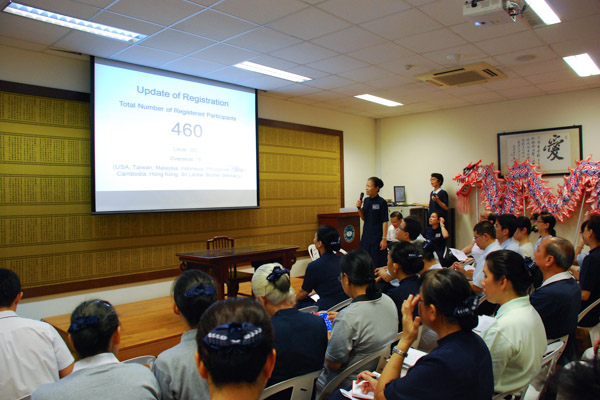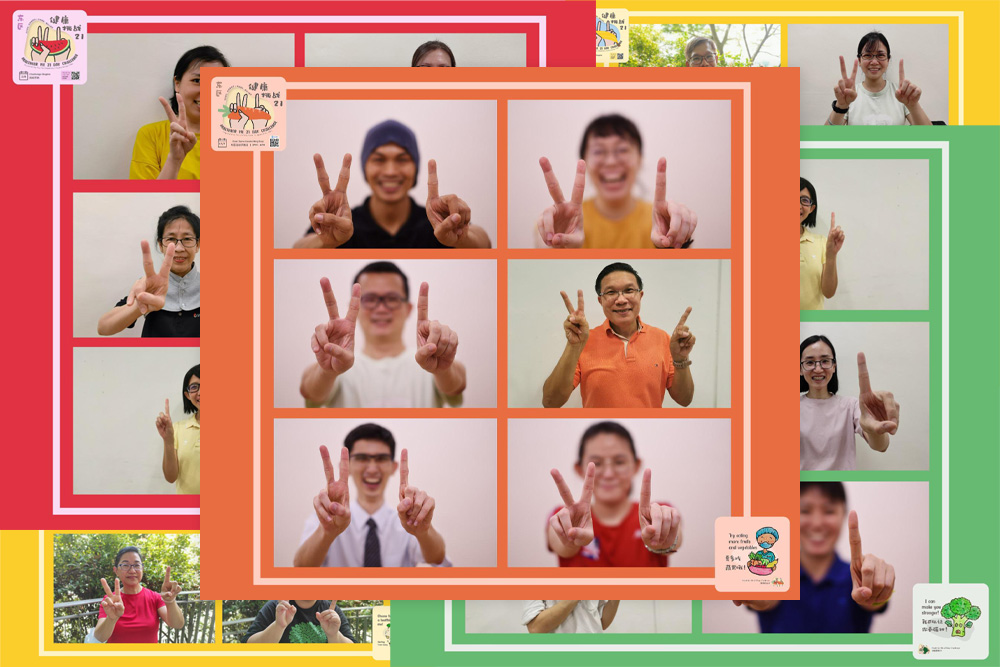
A would-be donor (left) swabs his inner cheek a few times in one minute with a cotton bud; the results of the cell sample will be used to determine a bone marrow match. (Photo by Teoh Moh Sang)
“In Singapore, leukaemia is the leading cause of death for children. The disease can strike regardless of one’s age, sex, or health condition. Every day, six people are diagnosed with blood disorders and there are at least 50 patients awaiting suitable bone marrow in order to extend their lives,” explained staff Elise Lee from the Bone Marrow Donor Programme (BMDP).
The BMDP was initiated in 1993 by a young couple who had lost their child due to the unavailability of a suitable bone marrow match. In the midst of their own grief, they could not bear to see other leukemia sufferers and their families undergo the same pain and were thus driven to set up a bone marrow donor database to provide hope for them.
“Over the past 22 years, some 51,000 people have registered themselves in the database, but this is still not enough.” Lee elaborated that the chance of a successful patient-donor match in unrelated persons is only 1 in 20,000. Nevertheless, the BMDP’s goal is to ‘Find a match for every patient’, and it plans to hit a target of 100,000 registered donors (in the database) in the next 3 years.
During the Bone marrow donation talk at the Tzu Chi Free Clinic, a number of the 21 attendees registered themselves as donors, while some took the donor information packs home with the intention of encouraging friends and family to register as donors, too.
Save Lives, Be a Marrow Donor
In contrast to other diseases, many congenital blood disorders cannot be cured by medications and a bone marrow transplant is the only hope for recovery. For leukaemia patients, such transplants are the last hope for survival after chemotherapy fails.
The global database of bone marrow donors stands at more than 2.5 million registered donors, yet there remain many leukaemia sufferers who are unable to find a suitable match.
In Singapore, healthy adults from 17 to 49 years of age are eligible to donate bone marrow. Once registered donors reach 60 years of age, their names will automatically be removed from the database. The donor registration process takes just five minutes: after filling in one’s personal data, medical history and contact numbers, two cotton buds are used to gently swab the inner left and right cheeks of the potential donor, and the process is completed without the need to draw blood or pay any fees.
The BMDP has also thoughtfully prepared a donor information pack which facilitates interested parties in completing the registration process at home, before returning the pack back to BMDP by mail. Upon receiving the cotton bud swabs from potential donors, the BMDP will send the cell samples in batches for laboratory testing. Two months later, the human leukocyte antigen (HLA) typing is completed and the data is uploaded into the database for matching. The BMDP bears the cost of the testing, which comes up to about S$150 for each individual.
Saving a Life Without Harming Oneself
Advances in medical science have simplified the bone marrow donation process and made it painless, and the risk involved for donors is almost negligible. Once a match is found, the registered donor will be invited to the BMDP’s office for a more detailed explanation of the process of bone marrow donation, and to undergo a body check up to assess for eligibility for donation.
Bone marrow donation can be carried out in two ways, either by donating bone marrow stem cells or peripheral blood stem cells. Majority of the donors choose to have their peripheral blood stem cells harvested. While this process requires a longer time (five to seven hours) to complete, it is otherwise similar to the procedure of blood donation and donors can go home after it is completed. Ms Lee explains that only the stem cells will be removed, and other blood components will be retained in the donor’s body.
To increase the growth of stem cells in the bloodstream, donors will receive a Granulocyte colony-stimulating factor (G-CSF) injection for four days in succession before the procedure. Some donors may experience some slight muscle ache, headache or symptoms of a cold.
Alternatively, donors can opt for bone marrow harvesting. “When bone marrow stem cells are drawn, a donor will not feel pain as it is done under general anaesthesia. The whole procedure only takes an hour or two and donors will be discharged the next day,” explained Ms Lee.
She further pointed out that the spinal cord will not be affected in the process as the bone marrow stem cells are drawn from the pelvic bone, and not the spine. Apart from some short-term muscle ache and fatigue, there are no other side-effects. The amount of stem cells drawn makes up only about 5% of the donor’s total bone marrow. In four to five weeks’ time, the donor’s body will naturally regenerate the bone marrow lost, hence, there are no lasting side effects.
Ms Lee shared that the biggest challenge that she faced during donation drives was the fact that the general public lacks an accurate understanding of bone marrow donation, and many would turn pale upon hearing this topic. Normally, many suitable donors will agree to donate without hesitation once they understand what the actual process entails. Yet, they frequently meet with opposition from their friends and family. In Singapore, as many as 40% of suitable donors decline to proceed with the donation.
In a short video clip shown during the presentation, “bone marrow hero” Wilson Quek was on the receiving end of many different opinions from the people around him upon finding out that he was a suitable donor. Some of them worried that he might not be able to have children after the procedure, while others feared that he might end up with side effects. While Wilson was affected by what he heard, he courageously chose to proceed with the donation eventually. “My stem cells can save the life of another person; what a wonderful and beautiful thing it is!” he said in the clip.
Today, Quek is a healthy father to four children and is testament to the reality that bone marrow donation has no lasting harmful effects on donors.
If It’s Right, Just Do it
Among the 21 attendees was Cai Wei Ni, a nurse from Khoo Teck Puat Hospital. She recalled how her seniors in nursing school shared with her that leukaemia patients tended to be in low spirits and would sometimes lose their temper as they suffered greatly from chemotherapy, frequent hospitalizations, and drawing of blood. After the talk, Ms Cai immediately registered to be a donor. “If it is within my means, why shouldn’t I be happy to help? Furthermore, the peripheral blood stem cell harvesting procedure is very convenient.”
Ms Cai’s father is of mixed Malay and Chinese parentage. After the talk, she understood that due to the mixing of genes, the possibility of a suitable bone marrow match is much lower than that of other racial groups. With her signing up, this means one more ray of hope for patients of mixed parentage.
“If my parents object to my decision of becoming a bone marrow donor, I will share all that I’ve learnt today with them. I believe they will support my decision after that,” she said confidently.
Safeguarding Lives with Conviction
Ms Lee has worked in the BMDP for two years now. Initially, she treated it like any other job but today, she works with much conviction and is filled with a sense of mission. This transformation was brought about by an emotional realization.
“Three months into the job, we organized a meet up of bone marrow donors and recipients. I cannot forget the scene of how recipients teared up the moment they stepped into the room and (were so emotional that) they could not speak. I myself was moved to tears, too. Then, (I witnessed) the daughter of a recipient gift a donor with a picture, with the words ‘Thank you for saving my mother’s life’ written below it. After some reflection, I realized just how meaningful my job was. ”
To Ms Lee, seeing the joy of patients who have recovered is her biggest motivation. She shared how moved she felt when patients who underwent successful bone marrow transplants visited her in her office. Seeing them with healthy bodies, especially how child patients were able to chat with her in a lively manner, her emotions ran deep as the sharp contrast between their current and previous states was not lost on her.
“To me, the patients’ lives before and after bone marrow transplantation are worlds apart – prior to transplantation, their world is so dark, but after that, their future looks bright,” shared Ms Lee. “Although there are not many attendees today, as long as their hearts have been touched, the message will be passed on to more people. (Therefore) I believe that (this event) is worthwhile!”
With such faith and conviction, one cannot but feel that Ms Lee will definitely achieve the mission she set out to do.

Speaker Elise Lee from the Bone Marrow Donor Programme (BMDP) told the audience that a successful patient-donor match in unrelated persons is only 1 in 20,000. (Photo by Teoh Moh Sang)

Cai Wei Ni (centre) said that she would share what she had learnt from the talk with her parents in the belief that they would support her decision to become a bone marrow donor. (Photo by Teoh Moh Sang)

Lee patiently answers questions from her eager audience during the Q & A segment. (Photo by Teoh Moh Sang)

After the talk, Lee stayed back to answer further questions from the attendees, some of whom had even signed up as donors on the spot. (Photo by Teoh Moh Sang)



